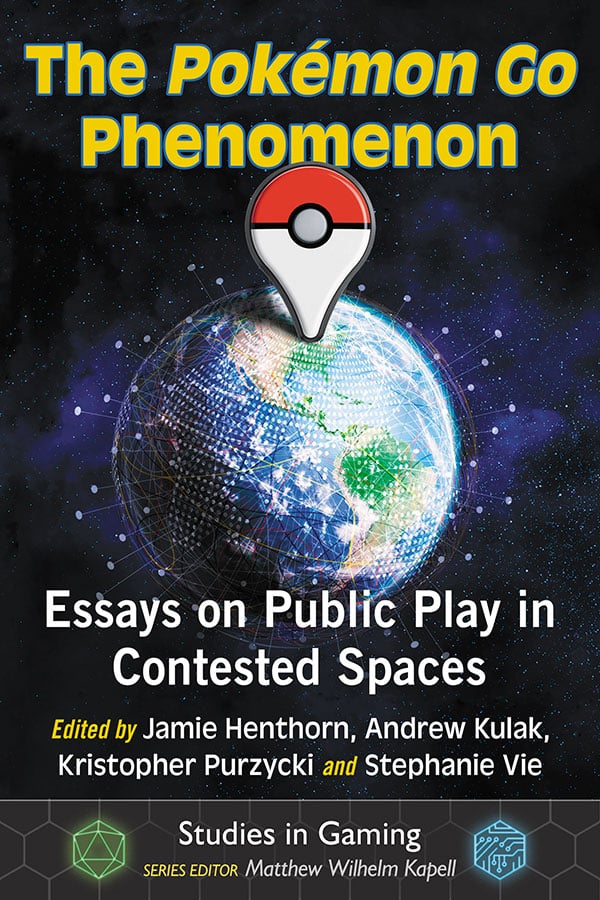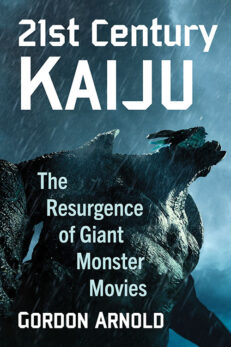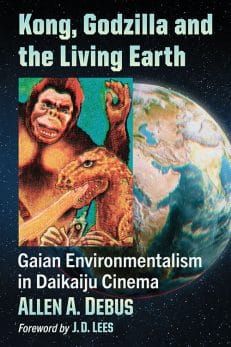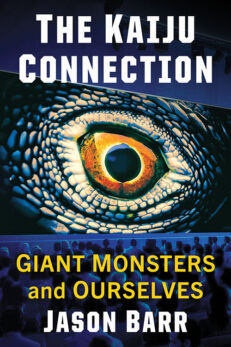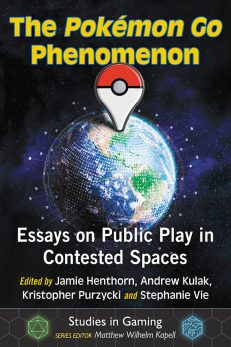The Pokémon Go Phenomenon
Essays on Public Play in Contested Spaces
$19.99 Original price was: $19.99.$9.99Current price is: $9.99.
In stock
About the Book
Pokémon Go is not just play—the game has had an impact on public spaces, social circles and technology, suggesting new ways of experiencing our world. This collection of new essays explores what Pokémon Go can tell us about how and why we play. Covering a range of topics from mobile hardware and classroom applications to social conflict and urban planning, the contributors approach Pokémon Go from both practical and theoretical angles, anticipating the impact play will have on our digitally augmented world.
About the Author(s)
Jamie Henthorn is an assistant professor of English and writing center director at Catawba College. She writes about and has published on games, fitness, and geek culture from a cultural rhetoric perspective.
Andrew Kulak is a doctoral candidate at Virginia Tech in Blacksburg, Virginia. He researches and has published on video games and literary theory, online pedagogy, and rhetorical approaches to digital and physical hybridity.
Kristopher Purzycki is a dissertator at the University of Wisconsin-Milwaukee and an editor of Proceedings of the Annual Computers & Writing Conference and OneShot: A Journal of Critical Play and Games.
Stephanie Vie is associate dean of Outreach College at the University of Hawai’i at Mānoa. She has published widely in peer-reviewed journals and edited collections, with a particular focus on games and social media.
Series editor Matthew Wilhelm Kapell teaches American studies, anthropology, and writing at Pace University in New York.
Bibliographic Details
Edited by Jamie Henthorn, Andrew Kulak, Kristopher Purzycki and Stephanie Vie
Series Editor Matthew Wilhelm Kapell
Format: softcover (6 x 9)
Pages: 235
Bibliographic Info: 13 photos, bibliographies, index
Copyright Date: 2019
pISBN: 978-1-4766-7413-1
eISBN: 978-1-4766-3651-1
Imprint: McFarland
Series: Studies in Gaming
Table of Contents
Acknowledgments vii
Introduction—Not Just Play: Spaces of Contention
(Jamie Henthorn, Andrew Kulak, Kristopher Purzycki and Stephanie Vie) 1
Part One. How We Play
Gaming Across the Years: Gotta Catch ’Em All Together (Wendi Sierra and Ginger Burgoon) 18
Playing Alone, Together: Pokémon Go, Public Mobility and Locational Privacy (Ryan S. Eanes and Claire Y. van den Broek) 32
The World’s Most Popular Fitness App (Jamie Henthorn) 49
Augmented Reality Design Through Experience Architecture (Jill Anne Morris) 62
Part Two. Why We Play
Rhetorical Augmentation: Public Play, Place and Persuasion in Pokémon Go (Jason Chew Kit Tham and Deondre Smiles) 80
To Be the Very Best … You Gotta Pay: Motivation, Resources and Monetizing Frustration (Eric Murnane) 103
Addiction and the Apocalypse: The Pathology of Pokémon Go (Kristen L. Cole and Alexis Pulos) 119
PokéStories: On Narrative and the Construction of Augmented Reality (Cody Mejeur) 136
Part Three. The Impact of Play
Raid Pass: Constitutive Capital Flows for Augmented Reality (Peter Schaefer and Margaret Schwartz) 156
For Anatopistic Places: Pokémon Go vs. Milwaukee County (Kristopher Purzycki )172
A Tale of Two Screens: Space, Ubiquitous Computing and Locative Gaming (Luiz Adolfo Andrade) 188
Placemaking Across the Digital-Physical Divide: Location-Based Mobile Gameplay as a Relay in the Emergence of Singularities (William Heili, Chen Xu and Nicholas Jon Crane) 205
About the Contributors 221
Index 225
Book Reviews & Awards
- “Thorough citations support each essay, providing a valuable snapshot of research…contributors cross-reference one another, creating a strong overall analysis…recommended”—Choice
Author Interview
Review Fix chats with Jamie Henthorn, Andrew Kulak, Kristopher Purzycki and Stephanie Vie about their collection of Pokemon Go-themed essays from McFarland and why the franchise and games are so much more than kids play.
Review Fix: How did this project start for you?
Jamie: One of the greatest aspects of our collaboration is that we all came to this project with different interests. I was interested in looking at a recurring use I saw early in public conversations about the app as a fitness app and as a strategy to encourage people to augment their physical therapy. Often these publications did not take into account the many ways different bodies are policed in public spaces, especially when walking/running. I felt as though these issues needed to be addressed. I know that Andrew and Kris were invested in considering the ways that games like Pokémon Go interacted with civic participation and who was allowed to use certain spaces. Stephanie was invested in the surveillance elements of the game. Coming to this project with different perspectives helped us to see the many ways Pokémon Go was important to how we were talking about games and public spaces.
Andrew: This project came out of a panel the four of us presented together at a Computers and Writing conference. We didn’t all present on Pokémon Go … I remember I presented on intersections of social media and place. But we wanted to keep the conversation going, and we realized that Pokémon Gowas a site where all of our research was overlapping and where we all shared a mutual interest both as researchers and as players.
Kris: I had never paid much attention to Pokémon but had been interested in augmented reality games since attending graduate school with Jamie who introduced me to Zombies, Run! About the time Pokémon Go was released, my wife was recovering from back surgery and had to walk about six miles a day to recuperate. We downloaded the game on release day and hit the park we had been going to. Unlike previous days, however, the park was jammed. The experience was incredible and I immediately knew that there was something worth talking about. It wasn’t much later that I contacted Jamie to discuss a collaborative project.
Stephanie: I was in a writing space where I was just finishing up some other projects—this was back in January/February 2017—and Kris and Jamie pitched the idea of a Pokémon Go collection around that time. Knowing and admiring their work, I said that I absolutely would be interested in helping co-edit, and because I had worked on other edited collection projects before, I noted that I’d be happy to provide a kind of mentoring role during the process by sharing any previous knowledge I had about the sometimes lengthy, sometimes mysterious process of getting an idea from “thought” to “final product.” I also got to meet and work with Andrew along the way, and this was great as we hadn’t yet collaborated. On the whole, this project was great because the team of co-editors worked so well together even though we were all in different states as we worked. The power of distributed teams!

Review Fix: Any challenges during the writing process?
Jamie: All writing comes with challenges, but by and large we worked with a great collection of writers who really helped us develop a strong collection. One of the few challenges we had was that we had way more proposals than we could possibly accept.
Andrew: I think editing was a unique challenge for this collection, if for no other reason than that a broad base of research on Pokémon Go doesn’t exist yet. We would come across simple style inconsistencies, including how we should stylize the title of the game, and conduct research to determine how best to reconcile writing from the different authors and our own contributions. Often, existing writing about Pokémon Go didn’t align with the publisher’s style, so we would have to get together and make a judgement call on how best to proceed. I hope we made good decisions!
Kris: Outside of what the others have said, many of the challenges I faced reflected some of the assumptions I had about writing and publishing in general. I was working on my dissertation at the time which included a chapter on Pokémon Go. When we lost a couple of authors, I figured it’d be easy to carve up that chapter into a shorter piece for the collection and the introduction. This was an extremely poor assumption on my part! Another challenge was creating the index, which I’d never attempted before. I learned that, contrary to expectations, this is not simply an automated process based on the popularity of certain terms. Instead, it was extremely deliberate and intentional with a lot of choices made based on what we wanted the collection to look like.
Stephanie: As my co-editors have mentioned already, we faced a few interesting challenges along the way—I think the one that was most intriguing for me personally was figuring out our house style guide. PokéBall, Poké Ball, Pokéball? Pokémon Gym or Pokémon gym? Would we go with Steel-type or steel-type Pokémon? Suffice it to say we had to have a style guide meeting at one point and just make some decisions, because there wasn’t always consistency out there. I think I got really handy at making diacritical marks on my computer keyboard as a result of this project.

Review Fix: Why does Pokémon Go matter?
Jamie: Pokémon Go has done a great deal to normalize a trend of public mobile play that was already gaining traction on the margins. Several phone-based augmented reality games had already come out, but the users of those games were relatively niche. What Pokémon gave to this field was a franchise so popular that enough players would be able to identify one another in person when playing outside. This normalization of this kind of play and the intergenerational element that normalization brought has been one of the major legacies of the game.
Andrew: As the various authors in the collection explore, Pokémon Go effected this cool convergence between physical and digital spaces with interesting implications for how we understand place and materiality more generally. Augmented reality certainly existed before Pokémon Go, but the widespread availability of the smartphone platform as well as the existing popularity of the Pokémon franchise attracted a lot of users in different places and made the impacts of augmented reality more manifest, even to non-players. Pokémon Go also elucidated class, gender, and geographical disparities in gaming, and in AR more generally, that require our ongoing attention.
Kris: Pokémon Go doesn’t matter. The social connections it creates, the spaces in which those connections take place, and the quality of that web of relationships does. If you look in the book, the game isn’t really the focus. Instead, the authors often position the games as a platform for love, empathy, anger, and conflict. So, if anything, Pokémon Go is one of the first “games” that revealed how more and more of these works are developed in the service of other motives.
Stephanie: Pokémon Go is a game that reveals complex issues in society. Ultimately, it’s not about this specific game, but it happened to be one that was wildly popular (and still remains popular among a hardcore group of fans) and also calls to our attention issues of surveillance, privacy, data mining; place and space; class, race, and gender; and many more. I can think of few other augmented reality games that have captured societal attention so widely and so rapidly and that have revealed so many of these cultural and societal issues in such significant ways.

Review Fix: How do you think it has changed Pop Culture?
Jamie: I was just a few years too old to get into Pokémon during its first US wave in the late 1990s (though my younger siblings were the perfect age). Pokémon have been a pop culture force for over 20 years now. What Pokémon Go added to that force was the chance for those who loved the franchise in their youth to return to it in a really accessible way and to invite generations too old to have loved the anime or trading card game an easy access point. Again, I think the multigenerational aspect of the game, and the ease with which it can be played with friends, children, parents, and grandparents, is perhaps the most engaging element. Of course, Pokémon Go has also had its fair share of critics who have noted that the game’s pop culture influence was rather short-lived, as many players abandoned the game within six months. However, I don’t know that those critics have considered this normalization and the fact that millions continue to play the game monthly.
Kris: At the risk of being the naysayer here, I don’t really think it has. Instead, Pokémon Go is a link on a chain of products created to generate revenue. Niantic’s latest endeavor is evidence of how these AR-driven products will continue to develop to both reinforce social connections and corporate profit margins.
Andrew: The initial popularity of the game has waned, but I think Pokémon Go did a lot to get AR into the hands of a lot of different users, even if they didn’t stick with it for the long haul. The combination of low barriers to entry and a well-known and, for some, nostalgic franchise introduced many to the possibilities of AR more broadly and the kinds of experiences it can afford. While there were AR games before, none achieved the same level of interest and critical engagement.
Stephanie: I think Pokémon was already a cultural juggernaut with a significant transmedia presence, so this was just the next instantiation of an existing popular culture phenomenon. However, the AR and mobile nature of the game made it so that just about anyone could pick up a phone or iPad and start playing Pokémon Go. While some have criticized so-called casual games for watering down their gameplay experience, I’m all for anything that brings gaming to larger distributed groups of people. As you see in the collection, families came together to play this game; people learned more about their communities, finding new PokéStops in different parts of town; individuals were pretty much forced to interact with each other to continue in the game. Sometimes it might be frustrating to have to turn to Discord to find raid partners or trading buddies, but I admit it gets one out of their comfort zone and out there finding new places and people.

Review Fix: What’s your background in gaming?
Jamie: I have been playing computer games since the late 1980s. I have always loved role-playing games with overly complicated battle systems. As life has moved me across the world, I have invested more in online cooperative play as a way to maintain strong personal connections over great distances. My interest in rhetoric and media studies in graduate school led to an interest in studying games academically. At the time, exergames were becoming a bigger deal, specifically games like Zombies, Run!, a gamified running app. I wrote a chapter of my dissertation on the communities built around exergames. Pokémon Go was released a few weeks after I defended my dissertation and doing a project on PG was a natural extension of that work.
Andrew: My earliest experience with video games was with educational titles in school like Oregon Trailand Stickybear Spelling. My family got our first home computer when I was around six. I remember on the first night after we set it up playing Missile Command until my right hand cramped so badly that I switched to my left to try to keep going. I played a lot of Maxis games and Civilization growing up, but I first felt really critically engaged by a game while playing Deus Ex when I was 14. I spent a lot of time during my first summer in high school trying to track down different literary texts and other references hidden in books and computers in the game. In graduate school, I ended up giving some of my first conference presentations on Deus Ex. While that couldn’t be the focus of my dissertation project for reasons outside the scope of this interview, I’ve kept active in gaming communities, and working on this collection was a great way to stay engaged.
Kris: I’ve been truly fortunate to grow up in a family who, despite having little money, always invested in emerging tech and games. I was given an Atari Pong console on my 4th or 5th birthday and it’s been uphill from there. By the time my parents bought me the Programming cartridge for the Atari 2600, I was chomping at the bit to recreate some of those early computer games floating around in elementary school. The Ultima games really hit home though—especially for a kid who had recently discovered TTRPGs. With networking tech, I was hitting up local MUDs and MadMaze (a game offered on Prodigy). I largely set aside games in my twenties. Half-Life was my re-introduction to games. Can you imagine going from MadMaze and text adventures to a 3D first-person experience? I still play HL to feel that awe again. Once I returned to graduate school, I was lucky enough to meet some cool folks who were studying games. I was immediately hooked and … well, here we are.
Stephanie: I actually talk about this quite a bit in a piece for First Person Scholar on “casual surveillance,” which you can read at http://www.firstpersonscholar.com/casual-surveillance/. I’ve always had computers and games at my disposal, thanks to a dad who was a former engineer and who helped me learn how to program my own games in BASIC. I also had a supportive family that included my two older brothers and my older sister; although they never wanted to play Monopoly with me when I was little (c’mon, guys, it doesn’t take THAT long to play a game … or maybe it does, but I still wanted to play!) I remember growing up with lots of board games, card games, and, later, computer and video games in the family that we all played.
Review Fix: Who’s your favorite Pokémon? Why?
Jamie: I had an answer, but changed it after seeing Stephanie’s. If I had a Pokémon as a pet, it would be a Charizard. Sassy, testy, more than slightly dangerous to house and kin, but also vulnerable pretty much describes all of my current pets.
Andrew: You know, Butterfree saved me a lot during the later stages of Pokémon Red and Blue when I was younger. I remember what a pain it was to evolve, but learning all of the powders and psybeam was definitely worth it. Butterfree seems so unassuming, but turns out to be a real gamechanger.
Stephanie: My husband and I play this game together where we ask, “What would be your Pokémon if you could have one real-life Pokémon?” and this seems really apt here. It depends. Personally, I love Skitty because I have a real-life Skitty cat who is beautiful and who is scared of everything except my husband and me and our other two cats. But I also love Eevee because she (all Eevees are “she” in my mind) can evolve into so many different forms, depending on how you care for her and what items you have. Eevee kind of represents, to me, the possibilities we all have inside us to be different people with different strengths depending on how we’re treated and what surrounds us.
Review Fix: What did you learn about yourself through writing this?
Jamie: I learned I need to work with great collaborators.
Kris: I want to second this. Because of this work, an inimitable benchmark for collaboration has been set. It’s basically set the bar impossibly high for me.
Andrew: I definitely learned a lot about how many moving pieces are involved in putting a book like this together. It taught me a lot about project management, communication, and keeping organized. I had some prior experience with technical copyediting, but seeing a book from start to finish, from putting together the initial call to reviewing the final proofs, is a ton of work and draws on a lot of different skillsets. This was my first experience with a book project like this, and I’m glad I got to work with such great writers and an amazing team of editors.
Stephanie: It really reinforced that great collaborators make a great project, and I absolutely won’t settle for less in working with a team.
Review Fix: What are your goals for the book?
Jamie: I hope the book helps others to see the ways that play affect our everyday lives and spaces. I’m especially hopeful that the book shows how play and performance are often disciplined and helps give us a vocabulary to further this conversation about mobile play.
Kris: One of the goals that motivated the book was a desire to put a “stamp” on how we talk about augmented reality, how it’s creating new places, and how those places conflict with those spaces of flesh and blood, history, and tradition. One of the hurdles we had to overcome, for example, is coming up with a definitive language of how we talk about Pokémon Go. This author refers to an item this way while another does another. Another goal for the book is simply to provide an account of July 6, 2016 (the North American release date) and the ripple effects that day had on American culture.
Andrew: I’d like to see the book find an interdisciplinary audience and spark collaborative conversations about how we approach games, design, and human-computer interaction more broadly. The authors in the collection do a great job of capturing different dimensions of Pokémon Go through their varied perspectives on games and play, and I’m likewise interested to see how readers coming from different backgrounds and with different interests can extend the conversation.
Stephanie: I hope that people find this book accessible and interesting to read. I hope that, even if you don’t play Pokémon Go—which you don’t have to in order to appreciate this book—you can find something in it that’s valuable to help forward those important conversations about societal issues I mentioned earlier. I hope it finds a place in classroom teaching and in spurring further conversations about augmented reality gaming and place and space.
Review Fix: What’s next?
Jamie: Much of my next work surrounds my administrative and teaching roles. I direct a writing center and have been thinking a great deal about how to make that space more playful. I’m also looking for ways to help junior faculty adapt and succeed in administrative positions. Finally, I’m developing work on play, civic mindedness, and fitness apps.
Kris: Since Niantic’s Harry-Potter-themed game was released, I haven’t been playing too much. It’s interesting how the layouts of the two games differ. Many of the Stops and Gyms that created issues here in Milwaukee have been removed in the new game, for example. Beyond that, I’m looking at live-streaming services (like Twitch) and how they utilize the aesthetics and ethics of public-access media to attract content producers.
Andrew: Since wrapping up this book, I’ve started a position in cybersecurity consulting and will be teaching a course at Virginia Tech on human-computer interaction. My work with the editors and authors from this book, as well as on my dissertation project, has led me to deeper research questions about the rhetoric of physical and digital and the consequences of a logic that presents the two as intrinsically distinct. I’m especially interested in the implications of this divide for cybersecurity and privacy.
Stephanie: I think we all joked at one point about a follow-up collection that would just be Pokémon Go and Marxism. I’m kidding here, but think of the potential. Pokémon Go and capitalism! Pokémon Go and surveillance. Pokémon Go and togetherness. There’s a lot more work that could be done in this area, especially because Pokémon Go is still evolving as a game, it has impacted real-life laws and social mores, and it is still garnering billions of dollars in revenue for parent company Niantic, Inc. I think Pokémon is like Facebook: While I might not have imagined back in the day that it’d still be here … it’s still here. And still impacting us globally.

